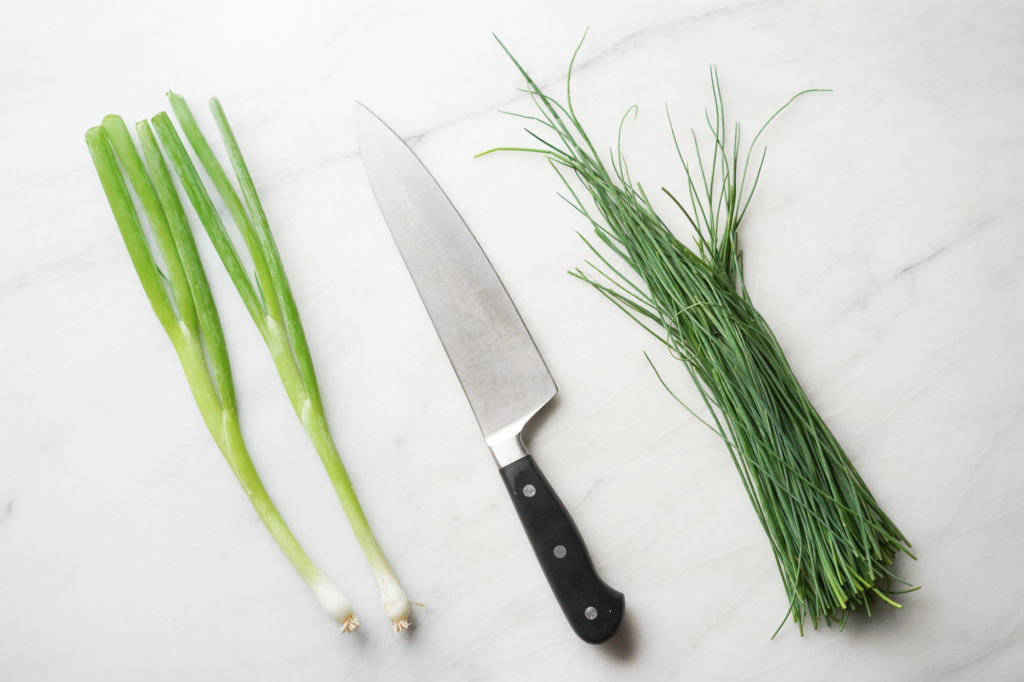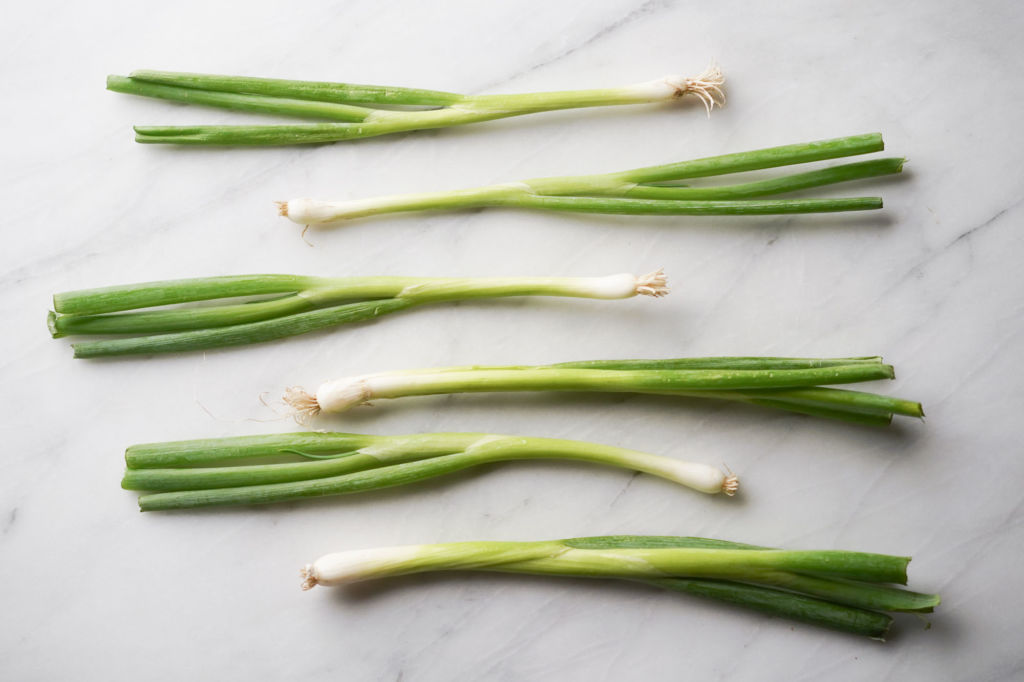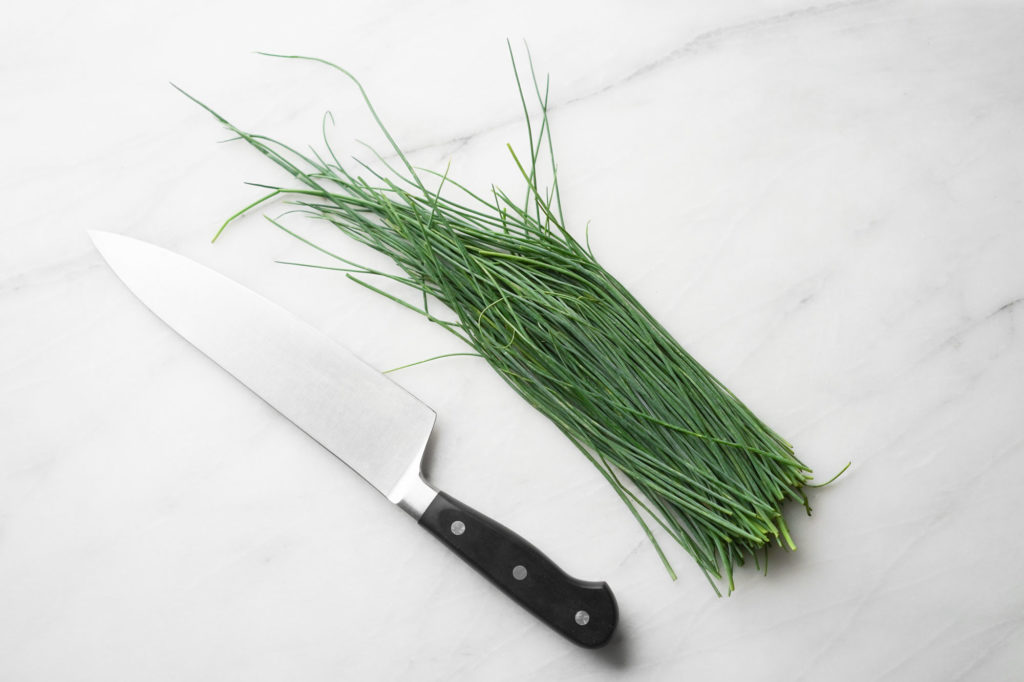Scallions vs. Chives vs. Green Onions: What’s the Difference?
Sprinkle scallions or chives on a dish, and it immediately becomes more flavorful. Scallions are one of my favorite garnishes for nearly any dish, from salads to tacos. But when you’re in the produce section trying to choose between scallions vs. chives, you may be wondering what the difference is.
Scallions and chives both come from the Allium genus, which has hundreds of species including onions, chives, leaks, shallots, garlic, scallions, and chives. They also look similar and have a signature “onion-y” flavor, though chive’s flavor is more subtle. So when can you use each and can they be used interchangeably?

What are Scallions (aka Green Onions)?
Scallions are long green straw-shaped vegetables from the genus Allium. The terms scallions and green onions are used interchangeably. So are they the same thing? Kind of. Remember, the Allium genus has hundreds of species.
Scallions are from the Allium fistulosum genus and species, also known as bunching onions or Welsh onions. They are a perennial that don’t grow from a bulb, so if you look at the bottom of scallions, you’ll see small white roots. Allium fistulosum are typically what you’ll find at the grocery store.

While the terms scallions and green onions are used interchangeably, green onions are technically from the Allium cepa genus and species. This can be confusing because Allium cepa are regular onions — think the round vegetable you dice. However, when harvested prematurely before the bulb (onion) forms, you’ll get green onions.
What about spring onions? Which are often confused with scallions. Spring onions are actually different. While they’re also a member of the Allium fistulosum genus and species, they grow from bulbs, have slightly skinnier stocks, and are more flavorful than scallions.
Scallions have a spicy, peppery flavor similar to an onion. The white part at the bottom has the strongest flavor. Scallions can be used fresh as a garnish or cooked into stir frys and scallion pancakes. They are firmer than chives and can be cut with a sharp knife without losing their integrity.
To optimize your green onion’s shelf life, remove the rubber band from the bundle, place the green onions upright in jar with about an inch of water, and cover loosely with a plastic bag. Change the water every few days, and your scallions will stay fresh for over a week! You can also store them in your vegetable drawer, but they’ll wilt faster this way.
Scallions can also be regrown from scraps. Growing up, we always had some sprouting in our kitchen or garden. They’re low maintenance, even if you have a brown thumb (me)! Trim the scallions about two to three inches above the roots. Put them in a glass of water covering the roots and place in full or partial sunlight. Change the water every 5-7 days. Within a week, you’ll start to see green shoots form. Once the shoots reach about 5 inches, you can plant them or use the shoots in your cooking.
If you plant scallions in your garden, they may flower. The fluffy white flowers are actually edible, though I’ve never tried to make anything with them.
What are Chives?
Chives are also part of the Allium genus, so they’re related to onions, scallions, etc, but they’re a different species — Allium schoenoprasum. They’re the only herb in this genus and typically eaten fresh as a garnish. When cooked, chives tend to lose their flavor.

Chives have a milder flavor than scallions, much thinner stocks, and are more delicate. It’s best to cut chives with sharp kitchen scissors to avoid crushing them with a knife.
Similar to scallions, you can store chives in the refrigerator either upright in about an inch of water, or wrapped in a damp paper towel and placed in a plastic bag. Both of these methods will keep your chives fresh for about a week.
Use chives to top your eggs, baked potatoes, soups, toast, salads, or dips. They’re especially good atop sour cream!
Scallions vs. Chives
So to sum it up, what are the similarities and differences between scallions and chives?
They both come from the Allium genus and have a similar appearance. However, chives are an herb, are more delicate, and have a subtler flavor. They’re best used as a garnish because they lose their flavor when cooked.
Scallions, also known as green onions, can be used fresh or cooked. They have a stronger flavor, though not quite as strong as an onion.
Can You Substitute Chives for Scallions?
Maybe. If you’re using the scallions as garnish, you can substitute chives, though they won’t be as flavorful and you may have to use more. If you’re using scallions in your cooking (like mixing them into a stir fry), chives aren’t a great substitute.
What are some of your favorite ways to use scallions vs. chives? Do you use them interchangeably?
You must be logged in to post a comment.